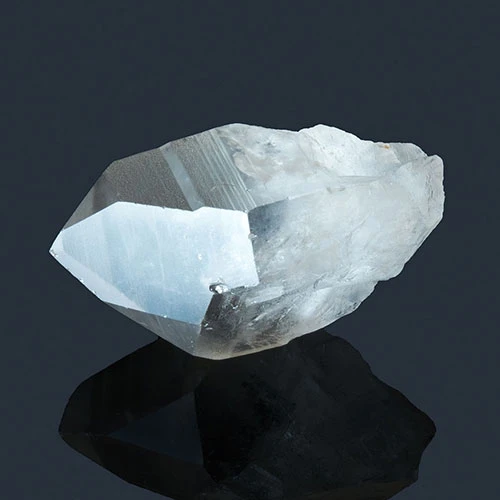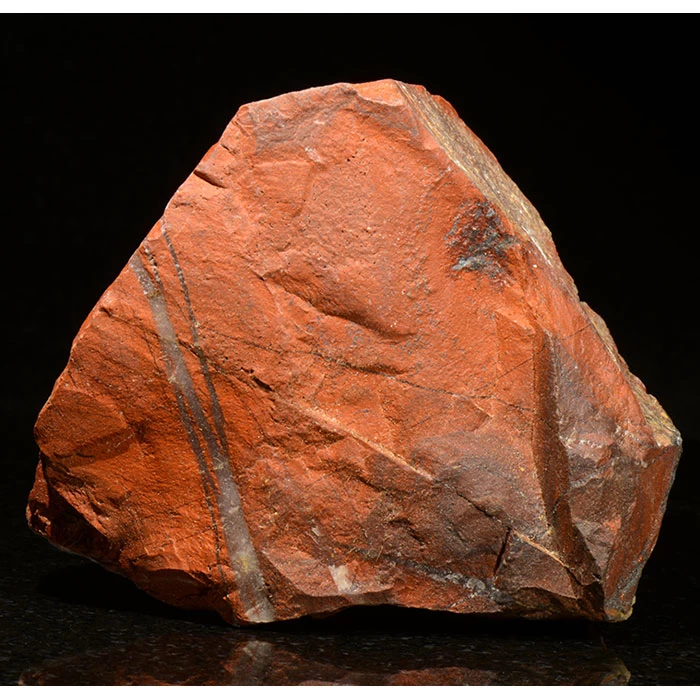
| Contents 1. Definition of a Gemstone 2. A Gemstone's Colour 3 Optical Phenomena in Gemstones 4. Hardness Toughness Stability 5. Faceted Stones and Cabochons 6. Article Pictures Reading time: 10 minutes |
Definition of a Gemstone
When a crystal, rock, or mineral is cut and polished to create an individual stone, mainly, but not exclusively, for personal adornment, it becomes known as a gemstone.
To be classified as a gemstone, the material must possess specific attributes, the most important being colour, although some gemstones are colourless.
Durability, beauty, and rarity are the other
Translucent gemstones such as ruby, topaz, peridot, and aquamarine are typically cut from a mineral's crystals. Opaque gemstones usually come from rocks or minerals. Examples include lapis lazuli, labradorite, bloodstone, and jasper.
Evidence of our fascination with gemstones can be found throughout history, and today, our bond with these natural curiosities is stronger than ever.
Regardless of age or culture, we're captivated by their colours, how they interact with light, and the transformation that occurs once a gemstone has been cut and polished.
Gemstones are mentioned in texts of many religions and have long been used in rituals and ceremonies. In ancient Egypt, they were used as part of the complex burial rituals of the pharaohs because they were believed to help ease the soul into the afterlife.
In many ancient cultures, people were often buried with their most prized possessions, which included gemstones. This ritual has been invaluable to historians and archaeologists.
For thousands of years, the finest gemstones have been sought after by those for whom money is no object. Jewellery and accessories featuring diamonds, emeralds, rubies, and sapphires can be found in collections around the world. Many feature gemstones considered priceless because of their size, rarity, or beauty.
The Green Vault in Dresden, the Smithsonian in Washington D.C, the Armoury Palace in Moscow, and the Tower of London, home to the British Crown Jewels, hold some of the most beautiful gemstones the world has ever seen.
Several factors are taken into account when classifying a gemstone. Although beauty, durability, and rarity are the primary characteristics, without beauty, the other two mean very little.
What causes the value of one gemstone to increase can have the opposite effect on another. Rubies, sapphires, and emeralds are prized for their colour, yet most diamonds are colourless.
The finest aquamarine can command an exceptional price if inclusion-free, while some varieties of quartz increase in value because of inclusions.

A Gemstone's Colour
The colour of a gemstone will often be its most important feature. It can also be the least reliable for accurate identification. Identifying a gemstone based on colour alone has led to countless mistakes being made.
Colour is determined by three main factors: the mineral's chemical composition, crystal structure, and natural defects and inclusions.
The slightest change in chemical composition, growth conditions, or crystal structure can bring about a change in colour.
This is why some gemstones of the same mineral variety can be found in a wide range of colours.
The characteristic responsible for colour may be consistent within a gemstone variety, or may vary depending on impurities. An impurity can also influence the amount of light that's absorbed or reflected.
The largest group of gemstones are those which are mostly colourless in their purest form. These stones tend to be translucent or transparent.
Without light, there would be no colour. The human eye only sees colour because of the way light interacts with an object. Our eyes and brain then work together to enable us to perceive the colours we see.
Objects only appear to be colourful when illuminated by light. As light fades, so does colour. Our eyes then only see black and grey.
A fine-grade gemstone must exhibit good depth of colour without being too pale or too dark. Colour should be uniform throughout, which can be an issue in some gemstones.
In amethyst, the shade of colour often varies within the same crystal. This characteristic, known as colour zoning, can be subtle or prominent.
Banded amethyst (also known as chevron amethyst) is the most extreme example of colour zoning.

Optical Phenomena in Gemstones
Many gemstones exhibit optical properties. These characteristics, often described as optical phenomena, can lead to a significant increase in value.
Optical phenomena are often caused by the way light interacts with the stone, its internal structure, or its inclusions.
The word 'lustre' is used to describe the way light reflects off the surface of a gemstone. Although the type of lustre known as vitreous tends to be the most common, there are several others.
Lustre should not be confused with brilliance, which is the reflection of light from within a cut gemstone.
Terms used to describe optical phenomena include play of colour, adularescence, schiller, labradorescence, aventurescence, chatoyancy, and asterism.
'Play of colour' in precious opal is caused when light is diffracted as it passes through an orderly arrangement of tiny silica spheres, producing a spectrum of colours.
Iridescence in labradorite is caused by light reflecting and interacting within extremely fine internal structures in the stone, producing flashes of colour that change with viewing angle. The colours we see are the reflection of light.
Although correctly known as schiller, the term labradorescence was coined because labradorite is renowned for this optical phenomenon.
The term adularescence describes the same effect in moonstone, but it produces a soft, milky-white glow or blue sheen.
'Aventurescence' can be seen in aventurine and sunstone. Asterism produces a four or six-rayed star in some cabochon-shaped gemstones caused by light reflecting off crystal inclusions of the mineral rutile.
The chatoyance in tigers eye and chrysoberyl is caused by a parallel band of light that reflects off fibrous inclusions within the stone. As the direction of light changes, the band of light moves. This gives the impression of movement on the stone's surface.
The one characteristic that all optical phenomena have in common is that they're caused by how light interacts with the stone or its crystalline structure. The extent to which the phenomenon can be seen depends on the angle of light and the angle from which the gemstone is viewed.
Hardness Toughness Stability
Durability is another factor that determines the suitability of a crystal, rock or mineral to be classified as a gemstone. This characteristic is comprised of three parts: hardness, toughness, and stability.
Hardness and toughness are often looked upon as being the same but are different.
Hardness relates to scratch resistance, meaning how easily one gemstone can be scratched by another. Mohs scale of mineral hardness is widely used for this purpose.
Toughness relates to a gemstone's resistance to cracking, chipping, pressure or breaking. It can also affect how easy it is to facet.
Although diamond may be the hardest mineral, it's not the toughest. Diamond grades 10 on the Mohs scale, whilst nephrite jade grades 6 to 6.5. However, nephrite is tougher than diamond because of its strong interlocking network of fibrous crystals.
Pearl grades 3, yet is very tough. If dropped from height onto a hard surface, there's a good chance it won't break. Diamond is extremely hard but not particularly tough. It's difficult to scratch but can fracture or cleave if struck along a cleavage plane, whereas nephrite and pearl can absorb impact more effectively.
Topaz is another hard mineral that grades 8 on the Mohs scale. Despite its hardness, topaz is fragile and can chip easily. It's also sensitive to heat and pressure, both of which can cause it to crack. When searching for information online regarding toughness in relation to rocks, minerals, or gemstones, most search results reference the Mohs scale of hardness. However, the Mohs scale is only used to determine hardness or scratch resistance, not toughness.
When searching for information online regarding toughness in relation to rocks, minerals, or gemstones, most search results reference the Mohs scale of hardness. However, the Mohs scale is only used to determine hardness or scratch resistance, not toughness.
It can be quite difficult to find information on toughness without using the correct geological term, which is 'tenacity'.
Stability refers to a gemstone’s resistance to chemicals, heat, light, and environmental exposure that can cause fading, alteration, or structural damage.
Using turquoise as an example, this natural mineral is delicate and porous, so can be easily damaged by pollutants in the atmosphere. It can also be damaged by moisture.
Another example is amethyst, which will fade with prolonged exposure to sunlight.
Clarity is taken into consideration when determining the value of certain gemstones, but it's not always relevant and depends on the type of stone. A fine aquamarine can be almost transparent and void of inclusions, yet it's incredibly rare to find a flawless emerald.
Flawless describes a gemstone that's completely transparent and free of inclusions, cracks, and other anomalies.
Faceted Gemstones and Cabochons
A gemstone can be polished as a cabochon or have facets cut into it. The purpose of both is to maximise beauty, which increases value.
A cabochon is a gemstone that has been polished to produce a smooth, rounded upper surface and flat base. The technique is used mainly on opaque stones, or those that exhibit minimal translucence.
The domed shape enhances surface colour and markings as well as optical phenomena such as chatoyance, schiller, asterism, and play of colour.
Highly translucent or transparent gemstones tend to be faceted. This involves cutting a series of flat reflective faces called facets into the surface. Facets enhance a gemstone's ability to reflect light, which improves colour, sparkle, and brilliance.
Article Pictures
Several of the pictures in our article are clickable and redirect to the original images. The first photo is black rutile inclusions in quartz.
The banded amethyst stones are from our collection. The labradorite stones exhibit the optical phenomenon of schiller or labradorescence.
The final photo is a colourless topaz crystal. The topaz and rainbow photos are courtesy of Stan Celestian.









